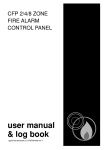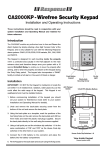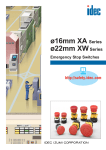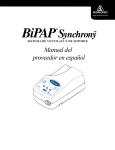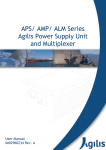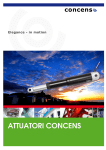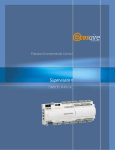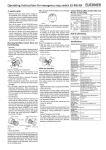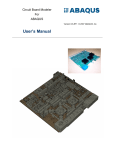Download SWL7500 User Manual Rev1
Transcript
USER’S GUIDE SWL-7500 Series Single Wavelength External Cavity Diode Laser U.S. Patents #6,556,599 Use of controls or adjustments or performance of procedures other than those specified herein may result in hazardous radiation exposure. 2584 Junction Ave. • San Jose, CA 95134-1902 • USA phone: (408) 919–1500 • e-mail: [email protected] • www.newfocus.com Warranty Bookham guarantees its New Focus TM SWL-7500 Single Wavelength Laser series to be free of material and workmanship defects for one year from the date of shipment or 5,000 to 6,000 hours of operation (depending on the model), whichever comes first. This warranty is in lieu of all other guarantees expressed or implied and does not cover incidental or consequential loss. Please note that each SWL-7500 series laser is custom built to the user’s exact wavelength specifications. Because of the custom nature of this product, returns are accepted only within 30 days from the date of purchase and are subject to a restocking fee of 65% of the original cost. Products described in this document are covered by U.S. Patent #6,556,599. Information in this document is subject to change without notice. Copyright 2009, Bookham. All rights reserved. NEW FOCUS, the Bookham, Inc. logo, and all Bookham, Inc. names and slogans are trademarks or registered trademarks of Bookham, Inc. in the U.S.A. and other countries. Littelfuse and Slo-Blo are registered trademarks of Littelfuse, Inc. Document Number PA004037 Rev 1. 2• Contents User Safety 5 Introduction . . . . . . . . . . . . . . . . . . . . . . . . . . . . . . . . . . . .5 Laser Safety . . . . . . . . . . . . . . . . . . . . . . . . . . . . . . . . . . . .5 Using the Safety Interlock . . . . . . . . . . . . . . . . . . . . . . . . .8 Getting Started 9 Introduction . . . . . . . . . . . . . . . . . . . . . . . . . . . . . . . . . . . .9 Unpacking the System. . . . . . . . . . . . . . . . . . . . . . . . . . . .9 Setting Up the Laser . . . . . . . . . . . . . . . . . . . . . . . . . . . .10 Starting the SWL-7500 Series Laser for the First Time .11 General Operation 13 Overview . . . . . . . . . . . . . . . . . . . . . . . . . . . . . . . . . . . . .13 What’s Inside. . . . . . . . . . . . . . . . . . . . . . . . . . . . . . . . . .13 Mounting the Laser Head . . . . . . . . . . . . . . . . . . . . . . . .14 Using the Front- and Rear-Panel Controls . . . . . . . . . . .15 Turning on the Power . . . . . . . . . . . . . . . . . . . . . . . . . . .16 Modulating the Laser Output. . . . . . . . . . . . . . . . . . . . . .17 Computer Control 19 Using the SWL-7500 ECDL Controller GUI Control Program . . . . . . . . . . . . . . . . . . . . . . . . . . . . . . . . . . . . . .19 Direct Communication With the Laser . . . . . . . . . . . . . .26 Understanding the Command Types . . . . . . . . . . . . . . . .26 Conventions. . . . . . . . . . . . . . . . . . . . . . . . . . . . . . . . . . .27 Command Summary . . . . . . . . . . . . . . . . . . . . . . . . . . . .28 Command Definitions . . . . . . . . . . . . . . . . . . . . . . . . . . .29 SWL-7500 Series Laser User’s Guide Contents • 3 Customer Service 33 Service . . . . . . . . . . . . . . . . . . . . . . . . . . . . . . . . . . . . . . .33 Technical Support . . . . . . . . . . . . . . . . . . . . . . . . . . . . . .33 Appendix I: Physical Specifications 35 Controller. . . . . . . . . . . . . . . . . . . . . . . . . . . . . . . . . . . . .35 Free-Space Laser Head . . . . . . . . . . . . . . . . . . . . . . . . . .36 Fiber-Coupled and Optically Isolated Laser Head . . . . .37 Appendix II: RS-232 Connector Wiring 39 RS-232 9-Pin D-Connector . . . . . . . . . . . . . . . . . . . . . . .39 Index 4 • Contents 3 User Safety Introduction Your safe and effective use of this product is of utmost importance to us at Bookham. Please read the following laser safety information before attempting to operate the laser. Laser Safety The laser radiation emitted from this unit may be harmful. Always follow these precautions: • Avoid direct exposure to the beam. • Avoid looking at the beam directly. • Be aware of and follow the warnings on the safety labels (examples are shown on page 7 and page 7). • The laser will exhibit a five-second delay before emitting light after pressing the on switch, as mandated by the US FDA. • The keyswitch must be turned to the full clockwise position to turn on the laser. The laser will not operate in the counter-clockwise position. The key cannot be removed from the controller when it is in the clockwise (on) position. • To completely shut off power to the unit, turn off the keyswitch, and unplug the unit. The Power button on the front of the controller controls power to the laser diode; even when the power to the diode is off, power is still being supplied to the laser head for temperature control. SWL-7500 Series Laser User’s Guide User Safety • 5 • Do not open the laser head or controller. Diode laser power at the wavelengths shown in the following table could be accessible inside the laser head. There are no user-serviceable parts inside the laser head or controller. Unauthorized opening of the head or controller will void the warranty and may result in misalignment of the laser cavity and/or irreparable damage to the internal components. The following table contains a list of wavelength ranges and maximum internal powers accessible inside the different model laser heads. Look at the label on top of your laser head for its model number and its specific wavelength. All models have -P (fiber -coupled), -D (head only), and -OI (free-space, optically isolated) options. Model Wavelength Range Max. Power SWL-7504 632.5–640 nm 50 mW SWL-7505 650–660 nm 50 mW SWL-7509 675–695 nm 50 mW SWL-7513, SWL-7513-H 765–790 nm 450 mW The actual output power of your laser will only be a fraction of the internal diode power shown here. Your laser will only operate at one specific wavelength within that model’s wavelength range. Fiber-coupling will reduce the output of your laser by roughly half. Label Identification The aperture and danger labels shown here pertain to different wavelength laser heads. Depending on your specific wavelength requirements, other labels similar to those shown may be used. 6 • User Safety R SE LA 00 r fo t 75 p Lce ex SW r: 1 .1 SA e 0 U 4 b : 0 2 1 0 m er 9 d u b -1 : n e 4 : e 0 a tic 3 1 lN m 5 at 0.1 No e u th 9 D 04 er d N g A o l n e 1 as 7 ,C M ria ele : ur CFR to L 200 T se t Se av er ac 21 ant 24, UC an Jo W w uf with ursu ne ROD e, S o P an lies s p d Ju ER P enu M mp tion date LAS Av AVOID EXPOSURE n o , C evia 50 IIIb tio d o. S nc N AS Ju L C 84 5 2 Figure 1: Labels on the front, top, and side of the free-space laser head LASER LIGHT IS EMITTED FROM THIS APERTURE SWL-7500 LASER Model Number: Serial Number: Wavelength: Power: Manufacture Date: E UR OS EXP GHT M OID R LI FRO AV LASE ITTED TURE DA NG ER IS EM IS A TH PER IN VIS AV IBL OID E DIR LA EC SE 15 T EX R 0m PO RA SU DIA W RE M TO TIO C A BE AlG W OXIMU AM N aA PER M s D AT OU IOD IO TP CLA SS E L N UT IIIb AS LA ER SE R PR OD UC INVISIBLE LASER RADIATION IS EMITTED FROM THIS APERTURE T DANGER 2584 Junction Avenue, San Jose, CA 95134-1902 USA DANGER VISIBLE LASER RADIATION Figure 2: Labels on the top of the fiber-coupled (-P) and free-space, optically-isolated (-OI) laser heads Complies with 21 CFR1040.10 and 1040.11 except for deviations pursuant to Laser Notice No. 50, dated June 24, 2007 CLASSIIIb LASERPRODUCT AVOID EXPOSURE INVISIBLE LASER RADIATION AVOID DIRECT EXPOSURE TO BEAM AVOID DIRECT EXPOSURE TO BEAM 450 mW MAXIMUM OUTPUT CW OPERATION AlGaInP DIODE LASER 450 mW MAXIMUM OUTPUT CW OPERATION AlGaAs DIODE LASER CLASS IIIb LASER PRODUCT CLASS IIIb LASER PRODUCT AVOID EXPOSURE LASER LIGHT IS EMITTED FROM THIS APERTURE SWL-7500-P LASER Model Number: DANGER Serial Number: Wavelength: LASER LIGHT Power: AVOID DIRECT EXPOSURE TO BEAM Manufacture Date: 450 mW MAXIMUM OUTPUT CW OPERATION AlGaInP DIODE LASER CLASS IIIb LASER PRODUCT 2584 Junction Avenue San Jose, CA 95134-1902 USA Complies with 21 CFR 1040.10 and 1040.11 except for deviations pursuant to Laser Notice No. 50, dated June 24, 2007 SWL-7500-P LASER Model Number: Serial Number: AVOID EXPOSURE INVISIBLE LASER RADIATION IS EMITTED FROM THIS APERTURE DANGER Wavelength: Power: Manufacture Date: INVISIBLE LASER RADIATION AVOID DIRECT EXPOSURE TO BEAM 450 mW MAXIMUM OUTPUT CW OPERATION AlGaAs DIODE LASER CLASS IIIb LASER PRODUCT 2584 Junction Avenue San Jose, CA 95134-1902 USA SWL-7500 Series Laser User’s Guide Complies with 21 CFR 1040.10 and 1040.11 except for deviations pursuant to Laser Notice No. 50, dated June 24, 2007 User Safety • 7 Using the Safety Interlock The safety interlock connector on the back of the SWL-7500 ECDL Controller is provided for external safety systems. The system is shipped with a jumper across the interlock. Do not remove this BNC jumper unless you are using the safety interlock feature; the laser will not emit light unless the interlock circuit is closed. The circuit carries 3.3 V DC. 8 • User Safety Getting Started Introduction This section outlines the basic steps needed to start using your SWL-7500 series laser system, including brief set-up and starting notes. For more detailed information on how to operate the instrument, refer to the “General Operation” chapter beginning on page 13. Unpacking the System Carefully unpack the SWL-7500 series laser system. Compare the contents against the packing slip and inspect them for any signs of damage. If parts are missing or you notice any signs of damage, such as dented or scratched covers, please contact Bookham immediately. The packaging is designed to accommodate a free-space laser head and a fiber-coupled laser head. Both compartments will be filled only if you ordered two laser heads. Save the shipping container and packing material for future shipping needs. SWL-7500 Series Laser User’s Guide Getting Started • 9 Setting Up the Laser 1. Mount the laser head: The laser head is shipped with a mounting bracket already attached. This bracket also serves as a heatsink to avoid overheating the laser head. Mount the laser head/bracket in a stable position with the output aperture pointing towards an appropriate beam block. Output-beam height is one inch. See page 14 for details on mounting techniques. 2. Position the controller: Position the controller within a cable length of the laser head (about five feet). The controller keyswitch should be off (fully counter-clockwise). 3. Connect the head and controller: Connect the controller to the laser head with the 26-pin to 15-pin D-connector laser cable provided (see Figure 3). Use only the supplied New Focus laser cable to connect the controller to the laser head. To ensure proper and safe operation of the laser, secure the cable to the laser head and controller using the captive attachment screws in the cable’s D-connectors. Figure 3: Controller to Laser Head Connection 26 Pin D-Connector Laser Cable 10 • Getting Started 4. Connect the power cord: Attach the power cord to the controller and plug it into a wall outlet. This laser utilizes a low-noise switching power supply. It should work at any normal line voltage. You should have been provided with a wall plug appropriate for your country. Alternatively, you can supply the unit directly with a low-noise +5 V DC (4 A max.). Refer to Figure 4 for connection information. The controller power input port was designed to accept a Kycon (San Jose, CA) KPPX-4P connector. Figure 4: Power Cord Connection P1 P3 P2 P4 shell PIN wire P1 NC P2 (+) P3 (–) +5V DC return P4, shell shield This is a view of the plug that must be constructed, not of the receptacle in the controller. 5. Optically isolate the laser: Take precautions to prevent back reflections into the laser head. Isolation can be achieved by angling your optics or with the use of an optical isolator. The degree of isolation required depends on how you are using the laser; contact New Focus technical support for help with your particular application. If your laser head is fiber-coupled (-P option) or optically isolated (-OI option), then your system already has an optical isolator within the laser head. Starting the SWL-7500 Series Laser for the First Time This section takes you through the basic steps of starting up and shutting down the laser. The controls and functions are described in more detail in the following chapter. SWL-7500 Series Laser User’s Guide Getting Started • 11 Figure 5: SWL-7500 ECDL Controller Front Panel 1. Turn on the system: Turn the keyswitch to the “ON” position (fully clockwise). The system will start up with the current set to 0 mA. After turning the keyswitch, allow the system a minimum of 20 minutes to reach a stable temperature before performing any critical work. Once the keyswitch is turned on, the system can be operated remotely through the USB or RS-232 ports. Refer to the “Computer Control” chapter beginning on page 19 for details. To prevent damage to the laser diode, the factory has limited the maximum current to the operating current listed on the Acceptance Test Data Sheet. 2. Activate the laser: Push the Laser On button to activate the laser power. The button will flash for 5 seconds, as mandated by the US FDA, before current flows through the diode. The Laser On indicator light in the button will remain lit while the laser is emitting light. Laser light should now be emitted from the aperture. Laser radiation emitted from this unit may be harmful. Avoid direct exposure to the beam. 3. Turn the laser off: To minimize the risk of power surges damaging the laser diode, push the Laser On button to turn off the laser when it is not in use and before shutting down the system. Turn the keyswitch off (fully counter- clockwise) to shut down the entire system. The status LED should remain lit and green, indicating that there is power being supplied to the controller and the diode is being temperature regulated. 12 • Getting Started General Operation Overview The SWL-7500 series laser is a robust, narrow-linewidth, laser source. The system consists of a power supply, laser controller, a laser head, and a laser cable. Each laser head contains head-specific information so that it can be used with any laser controller. This modular design allows you to switch wavelengths simply by changing the laser head (heads are available separately). The system can be operated manually, using the front-panel controls, or remotely, using one of the computer interfaces. What’s Inside The SWL-7500 series laser is an external-cavity diode laser (ECDL) based on a patented resonator design1. The customer-selected wavelength is set and stabilized at the factory using internal optics and precision temperature control. Laser output power is controlled by an ultra-low-noise current source. The controller contains the electronics for laser current, and laser temperature control and monitoring, as well as digital interface electronics. A dimensional drawing of the controller is located in “Appendix I: Physical Specifications” on page 35. The temperature of the laser cavity is set at the factory for optimum laser performance and should not, under normal circumstances, be adjusted by the user, although you can read the temperature using the computer interface (see “Computer Control” on page 19). The laser current controls the optical output power. This can be adjusted by using the computer interface, but should be left at the factory-set optimum current under most circumstances. 1. U.S. Patent #6,556,599. SWL-7500 Series Laser User’s Guide General Operation • 13 Mounting the Laser Head Proper mounting of the laser head is essential for stable wavelength operation. The output wavelength is weakly dependent on the temperature of the laser cavity, which is actively stabilized using a thermoelectric cooler (TEC). The TEC utilizes the laser-head housing as a heat reservoir. For this reason, the mount for the laser head needs to provide a good thermal path away from the laser head. The attached mounting bracket included with each laser head provides such a path when it is in contact with a large thermal mass such as an optical table. The laser head can be mounted with or without the enclosed mounting bracket (shipped attached to the laser head). Dimensional drawings of the laser head and the mounting bracket are shown in Appendix I on page 36. The mounting bracket is designed for use with metric (25-mm spacing, M6) or English (one-inch spacing, 1/4-20) breadboards. If you are mounting the laser head without the included mounting bracket, take steps to ensure it has an adequate thermal heat sink. Beam Height The laser beam height is one inch (25.4 mm) from the bottom of the mounting bracket. Optically Isolating the Laser After mounting the laser head, take precautions to prevent back reflections into the laser aperture. Isolation can be achieved by angling your optics or with the use of an optical isolator. The degree of isolation required depends on how you are using the laser; contact New Focus technical support for help with your particular application. If your laser head is fiber-coupled (-P option) or optically isolated (-OI option), then your system already has an optical isolator within the laser head. 14 • General Operation Using the Front- and Rear-Panel Controls Control of the SWL-7500 ECDL laser system is designed to be simple and straightforward. Figure 6: Controller front and rear panels 1 5 2 3 4 6 7 8 Front Panel 1. Laser Keyswitch: Locks out the ability to turn the laser on. Power is delivered to all functions of the laser except the diode if the keyswitch is turned off. The laser will not operate with the keywsitch in the counter-clockwise position. The key is not removable in the on (clockwise) position. 2. Laser On Push Button: Current to the diode is delivered to the laser when this button is pushed. The Laser On indicator light in the button will remain lit while the laser is emitting light. 3. Status LED: If the laser is in a normal operating mode, it will be green and continuously on. If the system is in an error state, the LED will be red. Information about the error can be obtained through the computer interface, although in most cases, simply SWL-7500 Series Laser User’s Guide General Operation • 15 cycling the power will eliminate the error condition and the laser will return to a normal operating mode. If the user is communicating with the laser through the computer interface, the green LED will flash, although this usually happens too quickly to observe as the commands and information that can be passed back and forth are communicated rapidly. The status LED indicates that the laser is plugged in and will be green regardless of the status of the Laser On button or the keyswitch position as long as power is supplied to the laser controller. 4. USB Connector: Insert a standard USB mini connector cable here and insert the other end into a Windows™-based PC for computer control of the laser. Only a single USB cable or an RS-232 cable needs to be used for computer control of the laser. Rear Panel 5. Laser Head: This connects directly to the laser head. Use only the New Focus-supplied 15-to-26 pin connector cable. 6. +5V: Power input from the standard switching power supply or other +5V source. See Figure 4 on page 11. 7. RS-232: Insert a standard RS-232 cable here and insert the other end into a Windows™-based PC for computer control of the laser. Only a single USB cable or an RS-232 cable needs to be used for computer control of the laser. 8. Interlock: BNC Laser safety interlock used to prevent laser emission in fault conditions such as unauthorized entry into room. The system is supplied with an interlock defeat connector. The interlock circuit is powered by a 3.3 V DC voltage. Turning on the Power To turn power on to the SWL-7500 series laser: 1. Turn the power keyswitch on the front panel to the full clockwise position. 2. Wait at least 20 minutes after turning on the keyswitch to allow the laser head to reach a stable temperature before acquiring valid data. 16 • General Operation 3. Press the Power button on the controller front panel to allow current to flow to the laser head. The button will flash during the five-second safety delay before the current is activated. The button will remain lit while current is flowing to the laser diode. The diode will not emit laser light until the current is set high enough to meet the threshold current. Before turning off the system, you should first turn off power to the laser diode by pressing the Laser On button. Modulating the Laser Output The SWL-7500 series lasers allows you to modulate the current (and hence the frequency) of the laser. For current modulation, use the high-speed SMA input on the back of the laser head. Figure 7: Location of HighSpeed Current Modulation Input Modulating the Current Since changes in the current affect the laser frequency, you may want to modulate the current in order to achieve fine-frequency modulation. The frequency modulation is due to changes in the index of refraction of the laser gain medium (the semiconductor diode) as a function of laser current. The degree to which the current affects the wavelength depends on the specific laser head you are using, but it is in the range of 25–150 MHz/mA. SWL-7500 Series Laser User’s Guide General Operation • 17 1. Turn off, and unplug, the diode power (the light in the Power button should be off). Failure to turn off the diode power before connecting the RF input could destroy the laser diode. 2. Connect the line for the input signal to the SMA connector on the back of the SWL-7500 laser head. Make sure the signal conforms to the following specifications: Current Modulation Input Guidelines Connector Type SMA Max. Voltage 1 Vp-p Input Frequency Range 50 kHz–100 MHz Impedance 50 Ω Modulation 20 mA/V This is a direct RF connection to the laser diode. Improper use could irreparably damage the diode. Do not exceed the 1 Vp-p input and use standard precautions for static discharge when using this input. 18 • General Operation Computer Control Using the SWL-7500 ECDL Controller GUI Control Program You can control the SWL-7500 series Single Wavelength Lasers through a graphical user interface, which is downloadable from the New Focus website. To download, install, and configure the GUI: 1. Go to http://www.newfocus.com/index.cfm?navid=36 and click on the SWL-7500 Software Download link. 2. You will be prompted to save the following file: SWL-7500_ECDL_Controller_GUIzip.zip 3. Create a folder in C:\Program Files named New Focus. 4. Unzip the file to this folder. 5. Create a shortcut to the SWL-7500 ECDL Controller.exe file you extracted from the zip file and place it in a convenient location, such as your desk top. 6. Connect either an RS-232 or USB cable between your computer and the SWL-7500 ECDL Controller. (You can only upgrade the firmware through the RS-232 cable, but this is rarely necessary.) 7. Turn the keyswitch on the laser front panel clockwise to the ON position. 8. Double-click the SWL-7500 ECDL Controller.exe file or the shortcut you created in step 5. The following screen will appear. SWL-7500 Series Laser User’s Guide Computer Control • 19 9. Select the proper communication port. Choose Communication > Configure Serial. 10. Depending on your communication method, select one of the following Control Ports from the Serial Port Configuration Control Port drop-down list: 20 • Computer Control • RS-232—Select the Com Port you have physically chosen on your computer • USB—N/A You can now control the laser from your computer. • Click to turn the laser on. After a five-second safety delay mandated by the US FDA, the laser will emit light. The GUI will change to show Laser On. • Click the Laser On/Off button again to turn off the laser. SWL-7500 Series Laser User’s Guide Computer Control • 21 While the laser will be operating at its optimum current and temperature, you can now adjust these parameters. It is advised that all of your work with the laser be performed at the factory default settings. In order to return the laser to its factory default settings, choose Laser Head > Factory Defaults or use the control panel to set the parameters manually. 22 • Computer Control You can view the status of the laser. This view will indicate if the laser current and/or Thermo Electric Cooler (TEC) are operating correctly. To view the status of the laser, choose View > Status. The following screen will appear indicating that the laser is operating correctly. If an error condition exists, the radio buttons will be red. SWL-7500 Series Laser User’s Guide Computer Control • 23 You can query the SWL-7500 ECDL Controller firmware version by choosing Firmware > Version. The following screen will appear: If you are using a USB cable to communicate with your laser and you need to update the firmware (under normal operating conditions, this will not be necessary) you must first connect to the laser through the RS-232 port and set the communications port properly as shown above. Then choose Firmware > Update. A Windows® dialog box will 24 • Computer Control open. Locate and select the new Firmware version. The Firmware update will proceed automatically. You can view the current and factory-set laser head parameters by choosing Laser Head > View Parameters. A screen similar to the one shown below will appear showing information about the laser head. SWL-7500 Series Laser User’s Guide Computer Control • 25 Direct Communication With the Laser Communication with the laser is also possible by directly addressing the serial or USB ports. The following section provides a guide to the usable command set. Make sure to address the correct serial port when issuing commands directly. Understanding the Command Types There are three types of commands understood by the SWL-7500 ECDL Controller: Set commands, Query commands, and Sense commands. • 26 • Computer Control Use Set commands to set or change a value. Examples would be commands that turn on the laser head or set the operating current. • Use Query commands to check the user- or factory-set values of the laser. Examples include checking the set value for the current and checking the number of hours of operation. • Use Sense commands to determine the actual values for the laser properties at any given time. For example, to check the actual operating current. Sense and Query commands evoke a response from the controller. There is no response from Set commands if they are accepted and properly executed. Conventions The following pages contain a summary of all available commands, followed by detailed definitions for each command. The following conventions are used in both the “Command Summary” and the “Command Definitions” sections. • The part of the command shown in uppercase represents the short form of the command. The commands are case insensitive. If the syntax shown is “:SOURce:CURRent?”, then the SWL-7500 ECDL Controller will accept any of the following: “:SOUR:CURR?”, “:sour:curr?”, or “:sour:current?”. The controller will not accept commands such as “:SOURC:CURR?” or “:sour:curre?”. • Values to be input are indicated by angle brackets (<>) and are separated from the command either by a space or by a colon, as shown in the command syntax. Programming for the SWL-7500 ECDL Controller When programming for the SWL-7500 ECDL Controller, keep the following rules in mind. • A command is not parsed until a new line character is received. • Numbers may contain at most 15 characters. Commands that expect integer values will truncate after any decimal point in the input. For example, an input value of “11.56” is truncated to “11”. • Only one command can be issued per line. SWL-7500 Series Laser User’s Guide Computer Control • 27 Command Summary System Information Queries Syntax Command Page :SYST:INF:SMAN? Instrument Manufacturing Date 29 :SYST:INF:HMAN? Laser Head Manufacturing Date 29 :SYST:INF:SHO? Instrument Operating Hours 29 :SYST:INF:DHO? Laser Head Operating Hours 30 :SYST:INF:HWAV? Laser Head Wavelength 30 System Commands Syntax :OUTP <power> Command Page Turn On/Off Power to the Laser Head 31 Current/Diode Commands Syntax Command Page :SOUR:CURR <current> Set Diode Current 31 :SOUR:CURR? Query Diode Current Setpoint 31 :SENS:CURR Sense Diode Current 31 :SENS:TEMP Sense Laser Temperature 32 Power/Laser Commands Syntax :OUTP <power> 28 • Computer Control Command Page Turn On/Off Power to Laser Head 31 Command Definitions System Information Queries Query Instrument Manufacturing Date Syntax :SYSTem:INFormation:SMANufacture? SWL-7500 ECDL Controller Actions Returns the date of system manufacture. Response “mm-dd-yy” (Month-Day-Year) Query Instrument Operating Hours Syntax :SYSTem:INFormation:SHOurs? SWL-7500 ECDL Controller Actions Returns the system operating time. Response “x Hrs.” range: 0 to 65536 (7.5 years) Query Laser Head Manufacturing Date Syntax :SYSTem:INFormation:HMANufacture? SWL-7500 ECDL Controller Actions Returns the date of laser head manufacture. Response “mm-dd-yy” (Month-Day-Year) SWL-7500 Series Laser User’s Guide Computer Control • 29 Query Laser Head Operating Hours Syntax :SYSTem:INFormation:DHOurs? SWL-7500 ECDL Controller Actions Returns the laser head operating time. Response “xxxxxHrs.” range: 0 to 65536 (7.5 years) Query Laser Head Wavelength 30 • Computer Control Syntax :SYSTem:INFormation:HWAVelength? SWL-7500 ECDL Controller Actions Returns the nominal head wavelength. Response “x.xx nm” System Commands Turn Laser On/Off Command Syntax :OUTPut <value> SWL-7500 ECDL Controller Actions Turns the laser head on or off Argument “0” for laser current off and “1” for laser current on Example Turn off power to the laser: :OUTP 0 Current/Diode Commands Set Diode Current Syntax :SOURce:CURRent <current> SWL-7500 ECDL Controller Actions Sets the diode-current setpoint. Argument x.x range: 0.0 to 300.0, units are in mA Example Set the diode current to 88.8 mA. :SOUR:CURR 88.8 Query Diode Current Setpoint Syntax :SOURce:CURRent? SWL-7500 ECDL Controller Actions Queries the diode-current setpoint. Response “x.xmA” range: 0.0 to 160.0 Example Read the setpoint for the diode current: :SOUR:CURR? ⇒ 99.3mA Sense Diode Current Syntax SWL-7500 Series Laser User’s Guide :SENSe:CURRent Computer Control • 31 SWL-7500 ECDL Controller Actions Returns the laser-diode current reading. Response “x.xmA” range: 0.0 to 180.0 Sense Laser Temperature Syntax :SENSe:TEMPerature SWL-7500 ECDL Controller Actions Returns the laser-temperature reading. Response “x.xC” range: 7.0 to 47.0 32 • Computer Control Customer Service Service The SWL-7500 series laser is designed as a maintenance-free laser, thus there are no scheduled service actions. If your laser does require service, repair, or calibration, please call for a Return Authorization Number before shipping the unit to Bookham. Technical Support Information and advice about the performance or operation of your SWL-7500 series laser is available from our applications engineers. For quickest response ask for “Technical Support” and have your model and serial number available. The model and serial number can be read from the top of the laser head label . Hours: 8:00–5:00 PST, Monday through Friday (excluding holidays). Toll Free: 1-866-NUFOCUS (1-866-683-6287 ext. 4091) (from the USA & Canada only) Phone: (408) 919-1500 ext. 4091 Support is also available by email: Email: [email protected] We typically respond to email within one business day. SWL-7500 Series Laser User’s Guide Customer Service • 33 34 • Customer Service Appendix I: Physical Specifications Controller Dimensions in inches. Controller Weight: 1.3 lbs. SWL-7500 Series Laser User’s Guide Appendix I: Physical Specifications • 35 Free-Space Laser Head Dimensions in inches. Weight of Free-Space Laser Head: 1 lb (0.5 kg) 36 • Appendix I: Physical Specifications Fiber-Coupled and Optically Isolated Laser Head Dimensions in inches. The free-space optically-isolated model (-OI option) does not have the fiber as shown in the illustration. Weight of Fiber-Coupled and Optically-Isolated Laser Head: 2 lbs (1 kg) SWL-7500 Series Laser User’s Guide Appendix I: Physical Specifications • 37 38 • Appendix I: Physical Specifications Appendix II: RS-232 Connector Wiring RS-232 9-Pin D-Connector The RS-232 connector on the back of the SWL-7500 ECDL Controller is a standard female 9-pin D-connector. The laser controller transmits data on pin 2 and receives data on pin 3 (see below). If you have trouble communicating with the laser over the RS-232 port, you may need to use a null-modem adapter or cable. Figure 8: RS-232 Female 9-Pin D-Connector 6 7 8 9 Pin Name 1 1 2 3 Tx Rx 4 Gnd Not Connected 2 Tx Serial Transmit Line 3 Rx Serial Receive Line 4 5 6–9 SWL-7500 Series Laser User’s Guide Description Not Connected Ground Digital Ground Line Not Connected Appendix II: RS-232 Connector Wiring • 39 40 • Appendix II: RS-232 Connector Wiring Index B beam height 14 bracket, mounting 14 C computer control 19 command definitions 29 command summary 28 controller front panel controls 15 current modulating 17 F front panel controls 15 H heatsinking 14 height, beam 14 help servicing the laser 33 technical support 33 I IEEE computer control 19 inputs current modulation 17 interlock, safety 8 isolation, optical 14 K keyswitch 16 L labels, safety 6 local mode 15 M modulating current 17 mounting bracket 14 mounting the laser head 14 O optical isolation 14 P power maximum diode powers 6 Index • 41 turning on the laser 16 R remote mode 15 RS-232 computer control 19 wiring diagram 39 S safety interlock 8 safety labels, identifying 6 servicing the laser 33 support, technical 33 T technical support 33 temperature considerations heatsinking 14 warming up 16 turning on the laser 16 W warming up the laser 16 wavelength ranges by model number 6 wiring diagram, RS-232 connector 39 42 • Index










































